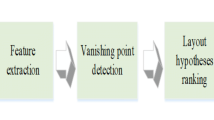Abstract
The most important things to realize such an intelligent system are core functions such as landmark detection, recognition and reconstruction. Since where we have core functions, the intelligent system can propagate other procedures like navigation, mapping, localization, etc. Thus, this paper describes an approach to construct a structural data for core functions by using geometrical structure of building. Firstly, line segments are detected. Then several processes such as rejecting noises, calculating dominant vanishing points, filtering the edges of building are used to detect the building surfaces. The criteria are created for decision of building detection function. Secondly, for each surface, a generative model including area, wall histogram and a list of local features are computed for the recognition function. Finally, the geometrical features as windows, doors, floors or rooms are estimated for reconstructing the building. The proposed method has been performed with large databases and sound results of all functions.
Preview
Unable to display preview. Download preview PDF.
Similar content being viewed by others
References
Fischler, M.A., Bolles, R.C.: Random sample consensus: a paradigm for model fitting with application to image analysis and automated cartography. Communications of the ACM 24(6), 381–395 (1981)
Fritz, G., Seifert, C., Paletta, L.: A Mobile Vision System for Urban Detection with Informative Local Descriptors. In: ICVS, vol. 30 (2006)
Garcin, L., Descombes, X., Men, H.L., Zerubia, J.: Building Detection by Markov Object Processes. In: IEEE int’l Conf., vol. 2, pp. 565–568 (2001)
Lee, S.C., Jung, S.K., Nevatia, R.: Automatic Integration of Facade Textures into 3D Building Models with a Projective Geometry Based Line Clustering. Computer Graphics Forum 21, 511–519 (2002)
Lowe, D.G.: Distinctive Image Features from Scale-Invariant Keypoints. IJCV 60(2), 91–110 (2004)
Madhavan, R., Hong, T.: Robust Detection and Recognition of Buildings in Urban Environments from LADAR Data. AIPR 39–44 (2004)
Pu, S., Vosselman, G.: Extracting windows from terrestrial laser scanning. In: Int’l Archives of Photogrammetry, Remote Sensing and Spatial Information Sciences, 36, part 3/W52, Espoo, Finland, September 12-14, pp. 320–325 (2007)
Robertson, D., Cipolla, R.: An Image-based System for Urban Navigation. BMVC (2004)
Shao, H., Gool, L.V.: Zubud-zurich Buildings Database for Image based Recognition, Swiss FI of Tech., Tech. report. 260 (2003)
Trinh, H.H., Jo, K.H.: Image-based Structural Analysis of Building using Line Segments and their Geometrical Vanishing Points. In: SICE-ICASE, October 18–21 (2006)
Trinh, H.H., Kim, D.N., Jo, K.H.: Cross Ratio-Based Refinement of Local Features for Building Recognition. Journal of LNCS (2008)
Zhang, W., Kosecka, J.: Hierarchical Building Recognition. IVC 25, 704–716 (2007)
Author information
Authors and Affiliations
Editor information
Editors and Affiliations
Rights and permissions
Copyright information
© 2009 Springer-Verlag Berlin Heidelberg
About this paper
Cite this paper
Trinh, HH., Kim, DN., Kang, SJ., Jo, KH. (2009). Building-Based Structural Data for Core Functions of Outdoor Scene Analysis. In: Huang, DS., Jo, KH., Lee, HH., Kang, HJ., Bevilacqua, V. (eds) Emerging Intelligent Computing Technology and Applications. ICIC 2009. Lecture Notes in Computer Science, vol 5754. Springer, Berlin, Heidelberg. https://doi.org/10.1007/978-3-642-04070-2_68
Download citation
DOI: https://doi.org/10.1007/978-3-642-04070-2_68
Publisher Name: Springer, Berlin, Heidelberg
Print ISBN: 978-3-642-04069-6
Online ISBN: 978-3-642-04070-2
eBook Packages: Computer ScienceComputer Science (R0)




